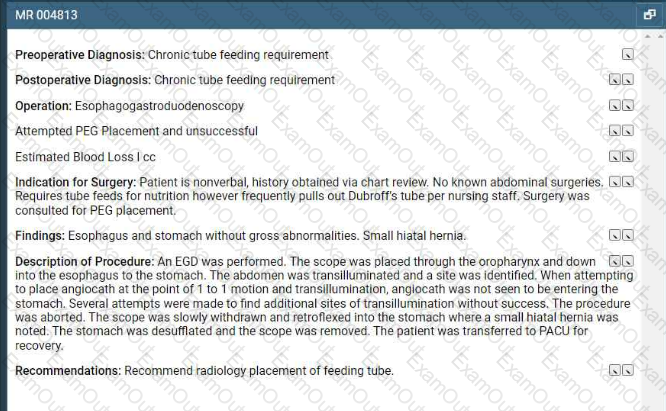View MR 002395
MR 002395
Operative Report
Pre-operative Diagnosis: Acute rotator cuff tear
Post-operative Diagnosis: Acute rotator cuff tear, synovitis
Procedures:
1) Rotator cuff repair
2) Biceps Tenodesis
3) Claviculectomy
4) Coracoacromial ligament release
Indication: Rotator cuff injury of a 32-year-old male, sustained while playing soccer.
Findings: Complete tear of the right rotator cuff, synovitis, impingement.
Procedure: The patient was prepared for surgery and placed in left lateral decubitus position. Standard posterior arthroscopy portals were made followed by an anterior-superior portal. Diagnostic arthroscopy was performed. Significant synovitis was carefully debrided. There was a full-thickness upper 3rd subscapularis tear, which was repaired. The lesser tuberosity was debrided back to bleeding healthy bone and a Mitek 4.5 mm helix anchor was placed in the lesser tuberosity. Sutures were passed through the subcapulans in a combination of horizontal mattress and simple interrupted fashion and then tied. There was a partial-thickness tearing of the long head of the biceps. The biceps were released and then anchored in the intertubercular groove with a screw. There was a large anterior acromial spur with subacromial impingement. A CA ligament was released and acromioplasty was performed. Attention was then directed to the
supraspinatus tendon tear. The tear was V-shaped and measured approximately 2.5 cm from anterior to posterior. Two Smith & Nephew PEEK anchors were used for the medial row utilizing Healicoil anchors. Side-to-side stitches were placed. One set of suture tape from each of the medial anchors was then placed through a laterally placed Mitek helix PEEK knotless anchor which was fully inserted after tensioning the tapes. A solid repair was obtained. Next there were severe degenerative changes at the AC joint of approximately 8 to 10 mm. The distal clavicle was resected taking care to preserve the superior AC joint capsule. The shoulder was thoroughly lavaged. The instruments were removed and the incisions were closed in routine fashion. Sterile dressing was applied. The patient was transferred to recovery in stable condition.
What CPT® coding is reported for this case?
An 8-year-old patient is placed under general anesthesia for treatment of a right orbital fracture due to a traumatic fall to the nose and face from a swing set. An on-call otolaryngologist is
asked to perform a general otolaryngologic examination to evaluate the patient. A mild nasal fracture is the diagnosis given by the otolaryngologist.
What is the CPT® and ICD-10-CM coding for the otolaryngologist's services?
A patient is diagnosed with compression fractures of the C6, C7 and T1 vertebrae. The patient agrees to have vertebroplasty. Bone cement is injected in the vertebral space until each of the two whole vertebral body is filled. The procedure is performed bilaterally.
What CPT® coding is reported?
A 5-year-old is brought to the QuickCare in the ED to repair two lacerations: a 3 cm laceration on her right arm and 2 cm laceration on her nose. Her arm is repaired with a simple one-layer closure with sutures. Her nose is repaired with a simple repair using tissue adhesive, 2-cyanoacrylate.
How are the repairs reported?
A mother brings her 2-year-old son to the pediatrician's office because he stuck a bead up his left nostril. The pediatrician uses a nasal decongestant to open the blocked nostril and removes the bead with nasal forceps.
What CPT® coding is reported?
View MR 006399
MR 006399
Operative Report
Preoperative Diagnosis: Chronic otitis media in the right ear
Postoperative Diagnosis: Chronic otitis media in the right ear
Procedure: Eustachian tube inflation
Anesthesia: General
Blood Loss: Minimal
Findings: Serous mucoid fluid
Complications: None
Indications: The patient is a 2-year-old who presented to the office with chronic otitis media refractory to medical management. The treatment will be eustachian tube inflation to remove the fluid. Risks, benefits, and alternatives were reviewed with the family, which include general anesthetic, bleeding, infection, tympanic membrane perforation, routine tubes, and need for additional surgery. The family understood these risks and signed the appropriate consent form.
Procedure in Detail: After the patient was properly identified, he was brought into the operating room and placed supine. The patient was prepped and draped in the usual fashion. General anesthesia was administered via inhalation mask, and after adequate sedation was achieved, a medium-sized speculum was placed in the right ear and cerumen was removed atraumatically using instrument with operative microscope. The tube is dilated, an incision is made to the tympanum and thick mucoid fluid was suctioned. The patient was awakened after having tolerated the procedure well and taken to the recovery room in stable condition.
What CPT® coding is reported for this case?
Which HCPCS Level II codes identify temporary services that would not be assigned a CPT® code, but are needed for claims processing purposes?
A patient underwent a cystourethroscopy with a pyeloscopy using lithotripsy to break up the ureteral calculus. An indwelling stent was also inserted during the same operative session on the same side. This service was performed in the outpatient hospital surgery center.
What CPT® coding reported?
A patient who has colon adenocarcinoma undergoes a laparoscopic partial colectomy. The surgeon removes the proximal colon and terminal ileum and reconnects the cut ends of the distal ileum and remaining colon.
What procedure and diagnosis codes are reported?

Refer to the supplemental information when answering this question:
View MR 004813
What CPT® and ICD-10-CM codes are reported?

